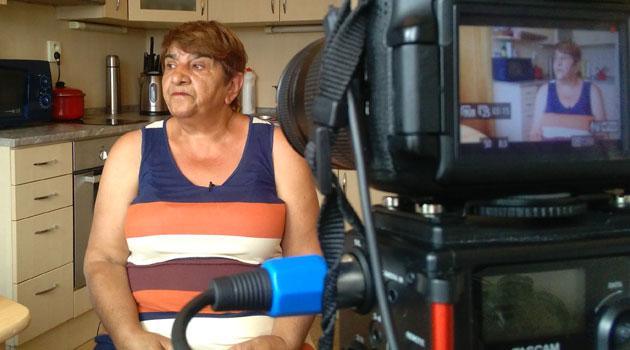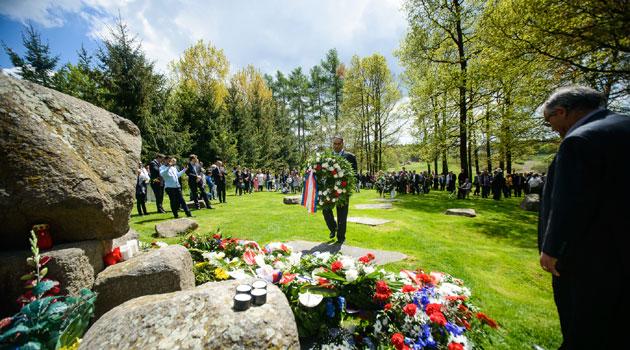Czech Republic: Unique "Memory of the Roma" project keeps historical memory alive through video

Over a cup of coffee in her apartment in Rokycany, Czech Republic, 67-year-old Květa Tůmová Tomášová recalls the stories of her family, whose roots are in the Šariš region of eastern Slovakia. She talks about labor camps, partisans, the Second World War, the postwar migration to the Czech Republic, her childhood in Rokycany, and the classroom where she and her brother Mírák were the only Romani children.
Tomášová is one of 50 eyewitnesses to history who have been visited in recent months by cameraman František Bikár and his team of interviewers – anthropologists and Romani Studies scholars who speak with the eyewitnesses and film their stories. They are giving a voice to specific people whose names are not recorded in the “Great History” sense, but who have directly participated in or witnessed the kinds of events that are not customarily written about in history textbooks.
“The Memory of the Roma project (Paměť Romů) is exceptional because of its aim. We are doing our best to capture the stories of ordinary people, not to just look for heroes and examples of society that are universal,” says Bikár, who is also one of the main figures behind the unique project.
Although the idea is not new – in 2008 a digital archive of such eyewitness testimony was created by Czech Radio, the Institute for the Study of Totalitarian Regimes, and the Post Bellum association – this is one of a very few projects that has focused directly on the memories and testimony of eyewitnesses who are Romani. “This is the only project that also concentrates on making the stories that are recorded available to the public, for example, to children in schools, so that they don’t end up somewhere in an archive just for research purposes,” Bikár says, and Memory of the Roma is collaborating with the Memory of Nations project and “exchanging” eyewitness interviews with them.
Ms Květa recalls the following in her interview: “It was sometime during the war, roughly around 1943. The Germans invaded Tolčemeš and the only people they let stay in their homes were the elderly people and the children. They took everybody else. Mama told me that first they forced to them to walk to Sabinov. In the morning they forced them to walk to the train station and to get into the freight cars. She said they were given nothing to drink or eat and that several people fell down and died on the spot.“
Memory of the Roma
The project began in 2016 and is a continuation of the educational activities of the ROMEA organization. Its aim is to familiarize the broader public with the history of Romani people, what it was like for them to live on the territory of the former Czechoslovakia during the 20th and 21st centuries and what they have lived through.
Currently a total of 50 videos of eyewitness narratives have been filmed. In addition, there are separate audio recordings that served as preparatory materials for the filming of the video interviews.
The edited videos are being gradually published on the project website, www.pametromu.cz. The final form of the website will include not just videos but brief biographies of the eyewitnesses, transcripts of the interviews, and texts that place the stories into the broader historical or thematic context.
The Memory of the Roma project is being implemented by ROMEA, o.p.s. with the financial support of Bader Philanthropies.
Listen to the voices of memory
“Not much is known in this society about the history of Romani people, the bare minimum is taught in the schools, if anything, and therefore Romani people themselves also frequently just know what they have heard their parents and grandparents talk about,” says the coordinator of the Memory of the Roma project, Kristina Dienstbierová. “Romani history is not something separate, it is a component of the history of our society, just as the Roma themselves are part of it, and therefore, in my opinion, this history should not be forgotten.”
“What’s more, if we know the historical context of the current situation of some Romani people, then that can lead to better mutual understanding. Personal stories in particular are, in my opinion, the best way to inform people about this history,” the project coordinator says, reminding us that these testimonies are not just sources of impersonal data, but are about specific people who are addressing problems in their lives like anybody else.
According to historian and political scientist Lukáš Valeš, who was recently interviewed for Czech Radio about how the eyewitnesses’ memories are captured and recorded through their own narratives (which is why the technique is called “oral history”), history cannot be perceived just through the actions of politicians, political events, or economics. “A particular history is created by real people and then is also perceived by specific individuals,” he says.
“In order to learn about the concrete facts of history, or above all about the perception of that history, to perceive what the decisions, motives, and approach to history taken by specific people is, it is important that they tell us their own specific story,” Valeš says. In other words, oral history reveals the way specific individuals see themselves in history and how, through their own fates, they see history itself.
Ordinary heroes
“By openly telling their stories, whether it’s about what frequently was a difficult life in Slovakia, or the genocide of the Roma, or the previous regime, or the post-Velvet Revolution disappointments, these people become real heroes in front of that lens,” Bikár believes. “When you get the opportunity to listen to them for several hours, you learn that the people sitting across from you have managed time and again to get back on their feet and take care of their families.”
The most recent edition of Romano voďi magazine featured the first part of a three-part series by historian Jana Hejkrlíková about the Memory of the Roma interviewees, with the first part being about the life of Margita Hlaváčová, while in the next edition the series will tell the life story of the author Ilona Ferková. Among the narrators of Memory of the Roma are people from different social strata, both those who are active in a civic and political sense and people who are absolutely unknown.
A random selection of the interviewees reveals that they include foster parent Daniela Cincibusová, a longtime member of the Kale music band, Emil Miko, and a former weaver who is a student of Romani Studies today, Monika Hejduková. Their stories are gradually being published on the website www.pametromu.cz, where you will find video recordings, transcripts of the stories, photographs and documentation.
“For the time being I have filmed roughly 6 000 minutes of narratives or 100 hours of video footage,” Bikár says. “What’s more, all year long there has been endless editing work – you complete the production of one set of materials and another 10 are waiting for you.”
The original, unedited recordings will be stored in the archive of the Museum of Romani Culture and at the Romani Studies Seminar of the Faculty of Arts at Charles University. Thanks to these narrative, parts of history are being kept alive that would otherwise have vanished like steam over a coffee cup.
“Rokycany was a terribly small town,” Ms Květa recalls in her interview. “Absolutely everybody knew each other. When I turned 15 in 1965 I went to work at Kovohutě [a metallurgical plant]. No other enterprise would hire me, you had to be 16 to work, but Kovohutě would hire you – one worked there for one year for no pay.”
